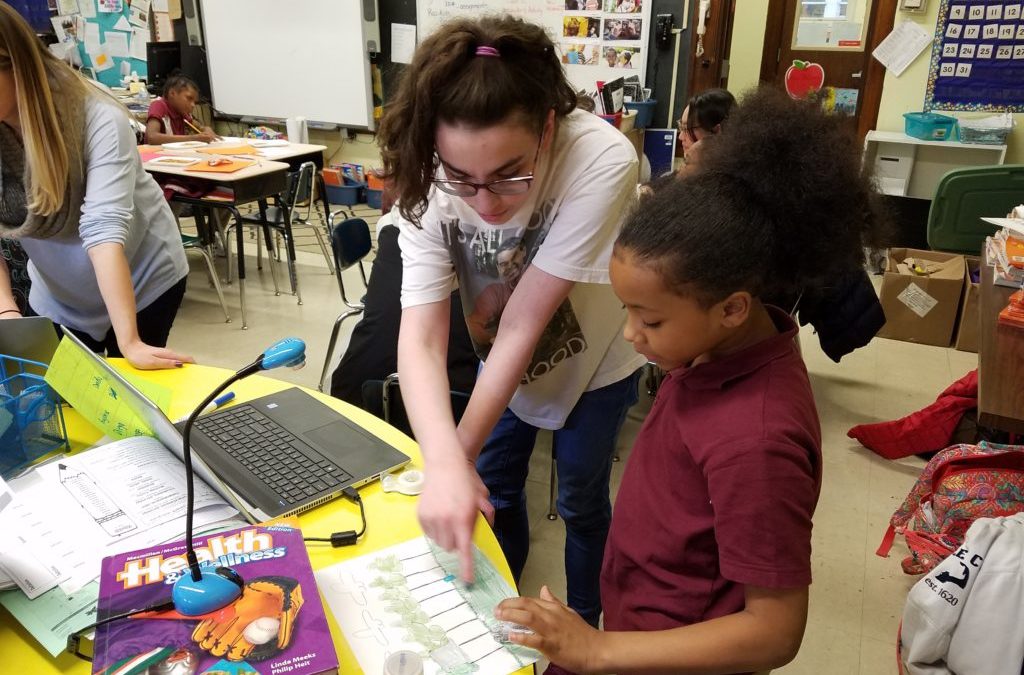Elizabeth Brown, William Paterson University, BrownE28@wpunj.edu
Anissa Conyers, Paterson School 12, aconyers@paterson.k12.nj.us
During a William Paterson University field based-literacy course held at a PDS, Paterson School 12, teacher candidates supported third-graders to write about a personal Small Moment. Molly, a teacher candidate, encouraged third grader, Dee, with her writing. Struggling to develop a narrative with a story arc, Dee spent four sessions writing individually about the ski mountain and main characters. During session 5, the use of stop-frame animation supported Dee to visualize her story and provided Molly with a pedagogical tool. As Dee moved her characters along her drawn ski mountain setting, and Molly clicked to capture the images, Dee found her story. Dee returned to the writing process and wrote about her fear— falling— and the ski instructor’s encouragement. After recording the final version of her story, Dee said with pride, “I chose the word inspired because the ski instructor truly inspired me to keep skiing.”
Mrs. Anissa Conyers, with 22 years of teaching experience, and Dr. Elizabeth Brown co-teach a field based-literacy course where teacher candidates teach third-graders reading and writing. For the past four semesters, Conyers and Brown have collaborated to transform students’ writing into stop-frame animation movies using the technology, HUE animation. Stop-frame animation strings together multiple single-framed images to create the impression of movement.
Over time Conyers and Brown have embedded animation into the writing process. First, teacher candidates helped students identify one Small Moment that occurred in one location. Next, the students sketched their setting and began describing it in writing. The illustrated setting supported the students to explain in writing the setting’s colors, textures, smells, and objects. Importantly, the setting ensured that the students’ Small Moment did not seep into multiple settings and timelines. Finally, the third-graders designed their 3-inch tall paper character puppets. Teacher candidates probed students to write about their characters’ feelings, dialogue, and actions. When needed, the third-graders took their character puppets out of their folders and had them re-enact the personal Small Moment to retrieve necessary details or dialogue for the narrative.
Just as preschoolers’ exposure to dramatic play centers with specific writing tasks developed their writing skills (Ihmeideh, 2015), designing the stop-frame animation supported third-graders’ writing. Through stop-frame animation, writers can visually watch their narratives unfold, critique missing or misleading details, and then revise their writing. Conyers and Brown found that the biggest obstacles to their stop-frame animations were time and equipment. After a struggle to get the HUE animation software on the school laptop during spring 2018, Conyers worked with the school’s PIR, Dr. Betsy Golden, to write a Donors Choose grant to purchase a compatible laptop. The new laptop allowed Conyers and Brown to give the third graders and teacher candidates more time to experiment with the animation program. In spring 2018 the students only captured 10-15 images for their animations; by spring 2019, each student was capturing on average 60 images. Mrs. Conyers’s students are now independently using stop-frame animation to present their final Folklores writing project.
References
Ihmeideh, Fathi. “The impact of dramatic play centre on promoting the development of children’s early writing skills.” European Early Childhood Education Research Journal 23, no. 2 (2015): 250-263.
